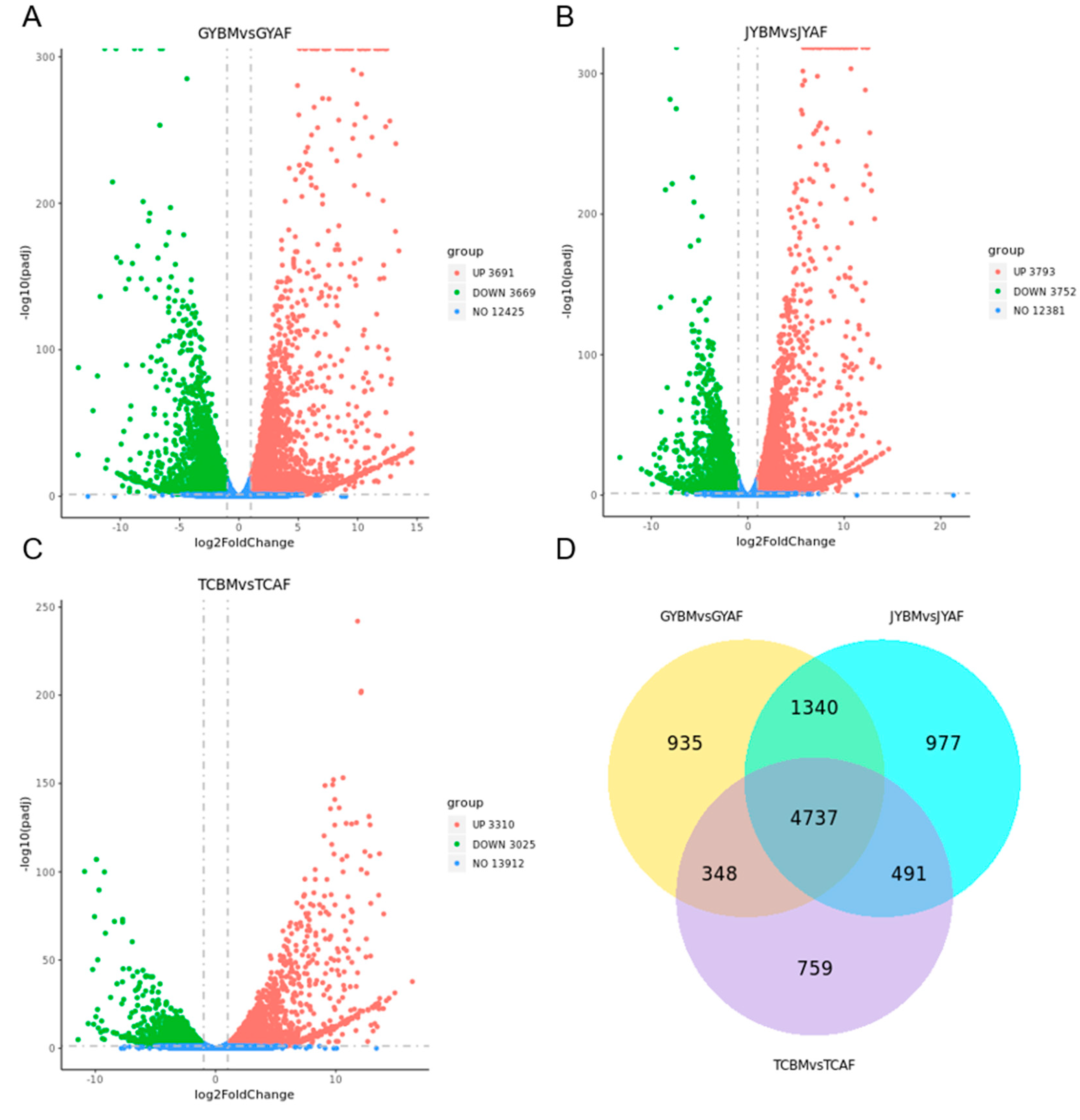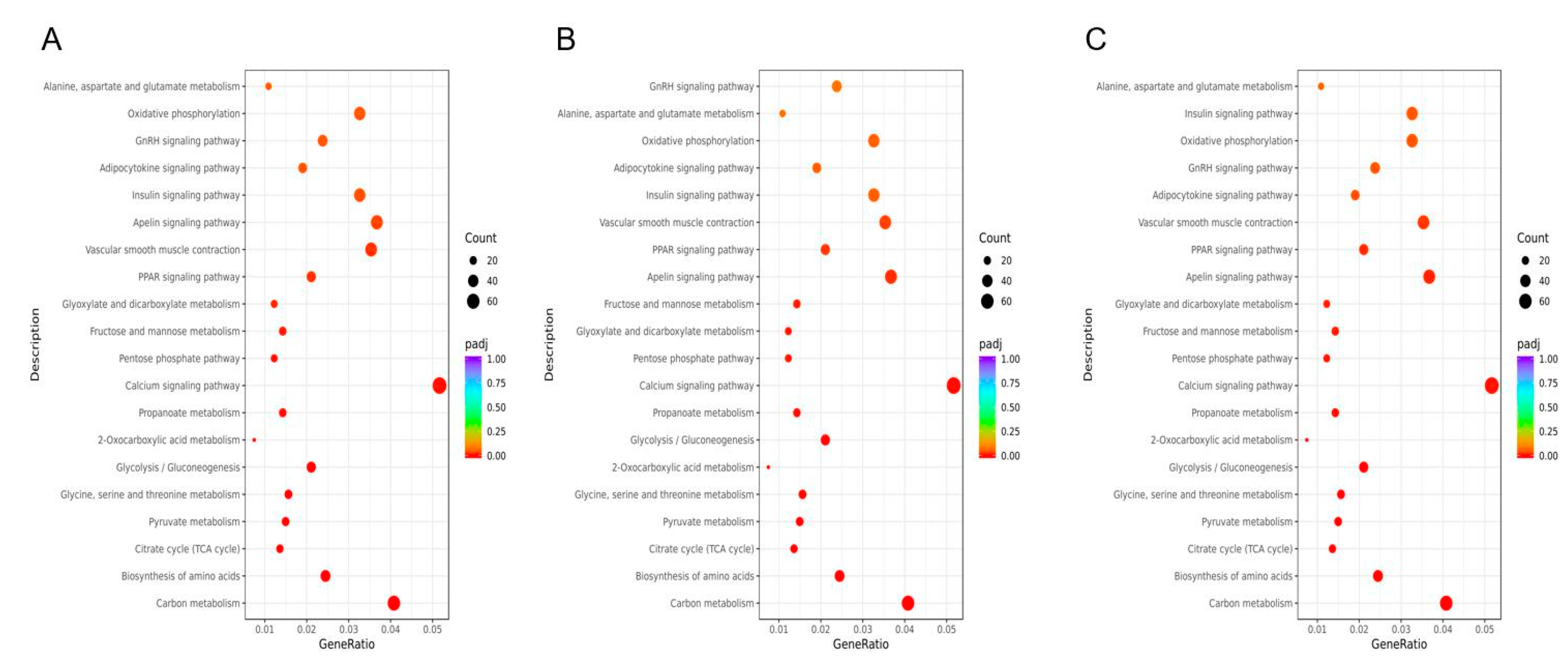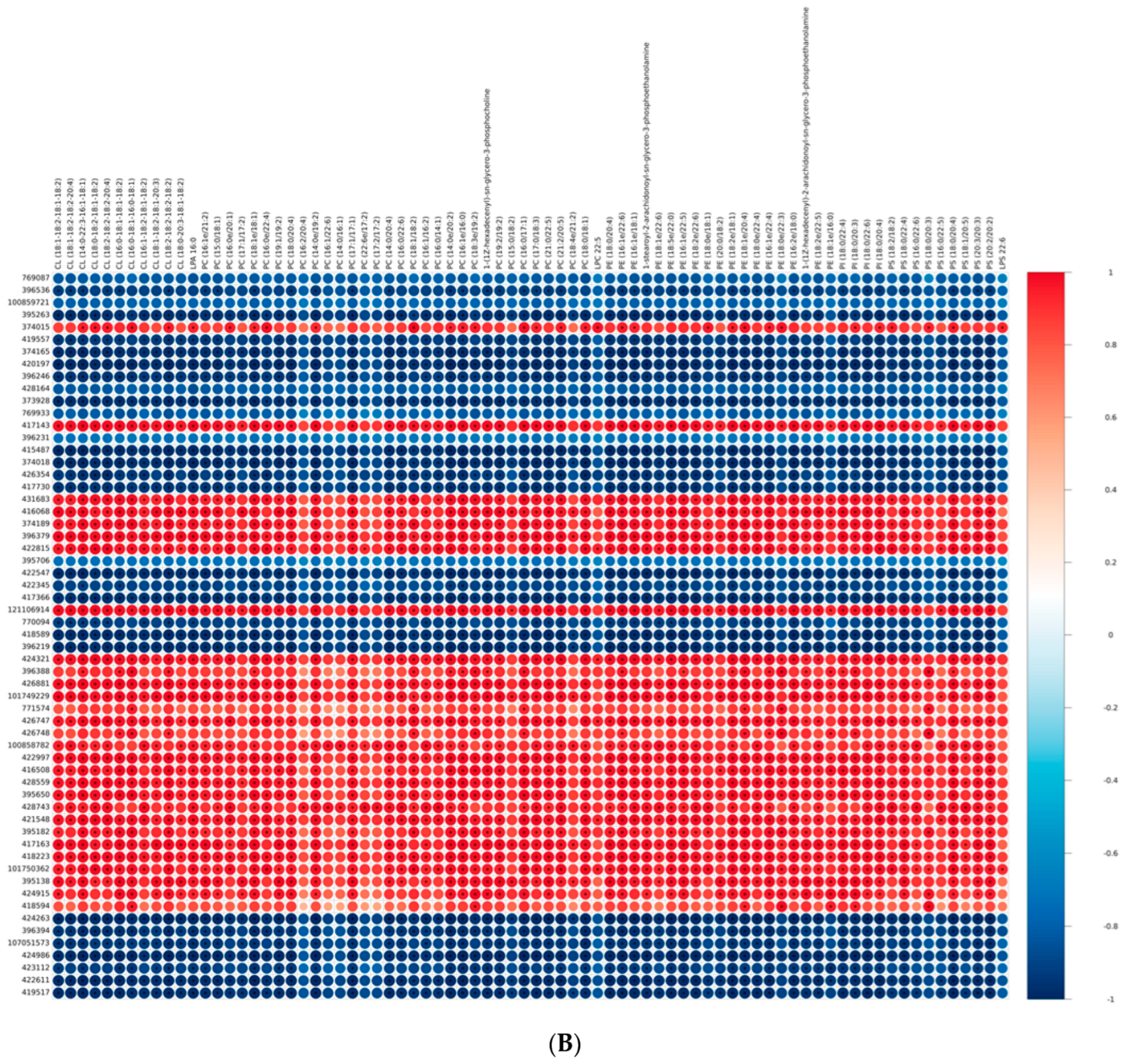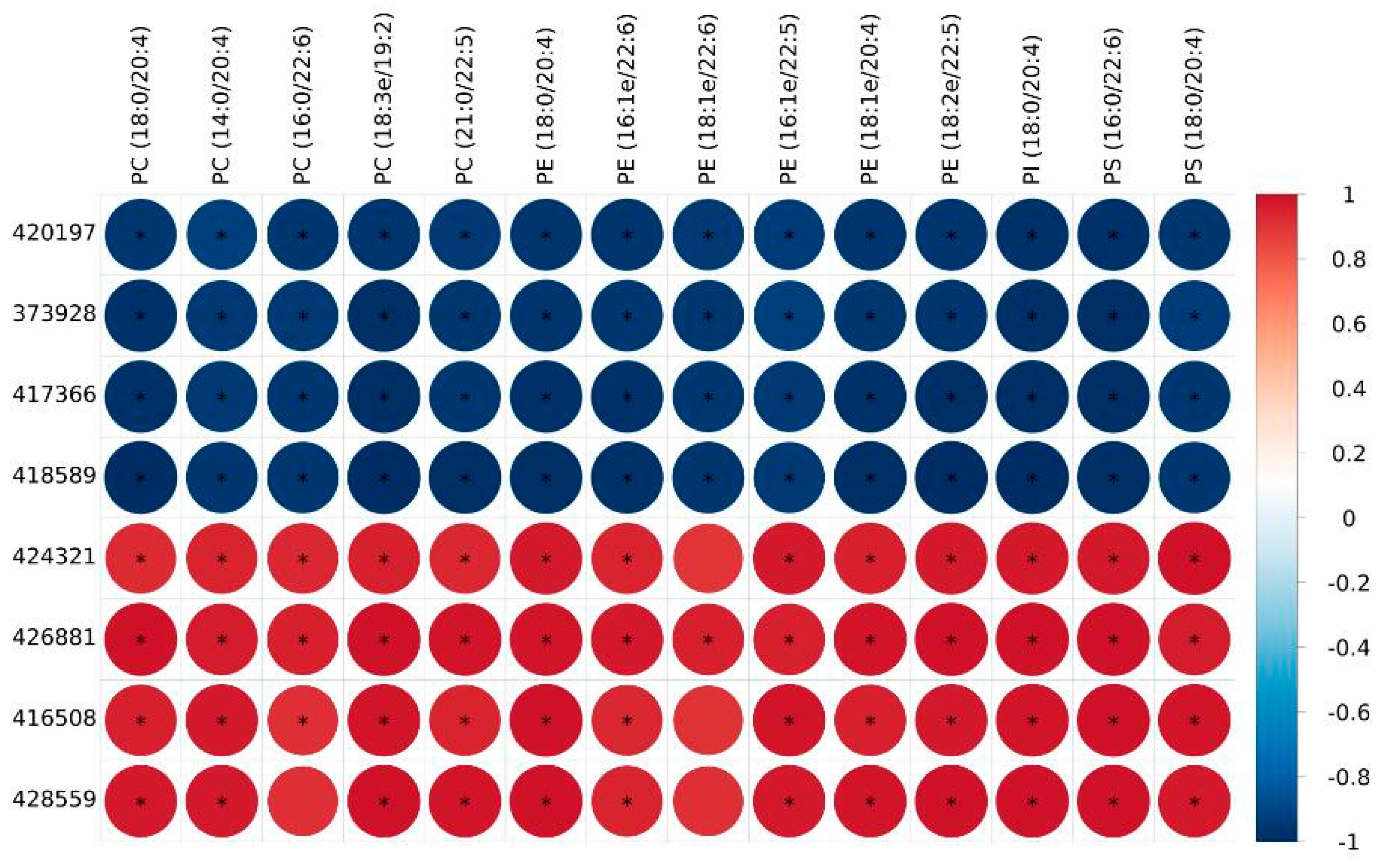Molecular Regulation of Differential Lipid Molecule Accumulation in the Intramuscular Fat and Abdominal Fat of Chickens
Abstract
1. Introduction
2. Materials and Methods
2.1. Animals and Sample Collection
2.2. Transcriptome Profiling
2.3. Differential Expression Analysis and KEGG Enrichment Analysis
2.4. cDNA Synthesis and Real-Time qRT-PCR Analysis
2.5. Lipid Extraction and Lipidomic Analysis
2.6. Integrated Analysis of Transcriptomics and Lipidomics
3. Results
3.1. Overall Description of Sequencing Data
3.2. Identification of DEGs between AF and BM
3.3. KEGG Enrichment Analysis of DEGs Involved in Lipid Metabolism
3.4. Gene Expression Validation of DEGs using qRT-PCR
3.5. Correlations between Shared DEGs and Differential Lipid Molecules
4. Discussion
5. Conclusions
Supplementary Materials
Author Contributions
Funding
Institutional Review Board Statement
Informed Consent Statement
Data Availability Statement
Conflicts of Interest
References
- Fouad, A.M.; El-Senousey, H.K. Nutritional factors affecting abdominal fat deposition in poultry: A review. Asian-Australas. J. Anim. Sci. 2014, 27, 1057–1068. [Google Scholar] [CrossRef]
- Claire, D.H.; Paul, W.; Shen, X.; Jia, X.; Zhang, R.; Sun, L.; Zhang, X. Identification and characterization of genes that control fat deposition in chickens. J. Anim. Sci. Biotechnol. 2013, 4, 43. [Google Scholar] [CrossRef]
- Chartrin, P.; Méteau, K.; Juin, H.; Bernadet, M.D.; Guy, G.; Larzul, C.; Rémignon, H.; Mourot, J.; Duclos, M.J.; Baéza, E. Effects of intramuscular fat levels on sensory characteristics of duck breast meat. Poult. Sci. 2006, 85, 914–922. [Google Scholar] [CrossRef] [PubMed]
- Hocquette, J.F.; Gondret, F.; Baéza, E.; Médale, F.; Jurie, C.; Pethick, D.W. Intramuscular fat content in meat-producing animals: Development, genetic and nutritional control, and identification of putative markers. Animal 2010, 4, 303–319. [Google Scholar] [CrossRef] [PubMed]
- Cao, S.; Tang, W.; Diao, H.; Li, S.; Yan, H.; Liu, J. Reduced Meal Frequency Decreases Fat Deposition and Improves Feed Efficiency of Growing-Finishing Pigs. Animals 2022, 12, 2557. [Google Scholar] [CrossRef] [PubMed]
- Leng, L.; Zhang, H.; Dong, J.Q.; Wang, Z.P.; Zhang, X.Y.; Wang, S.Z.; Cao, Z.P.; Li, Y.M.; Li, H. Selection against abdominal fat percentage may increase intramuscular fat content in broilers. J. Anim. Breed. Genet. 2016, 133, 422–428. [Google Scholar] [CrossRef] [PubMed]
- Li, D.L.; Chen, J.L.; Wen, J.; Zhao, G.P.; Zheng, M.Q.; Liu, C. Growth, carcase and meat traits and gene expression in chickens divergently selected for intramuscular fat content. Br. Poult. Sci. 2013, 54, 183–189. [Google Scholar] [CrossRef]
- Cui, H.X.; Liu, R.R.; Zhao, G.P.; Zheng, M.Q.; Chen, J.L.; Wen, J. Identification of differentially expressed genes and pathways for intramuscular fat deposition in pectoralis major tissues of fast-and slow-growing chickens. BMC Genom. 2012, 13, 213. [Google Scholar] [CrossRef]
- Ma, X.; Sun, J.; Zhu, S.; Du, Z.; Li, D.; Li, W.; Li, Z.; Tian, Y.; Kang, X.; Sun, G. MiRNAs and mRNAs Analysis during Abdominal Preadipocyte Differentiation in Chickens. Animals 2020, 10, 468. [Google Scholar] [CrossRef]
- Sun, W.X.; Wang, H.H.; Jiang, B.C.; Zhao, Y.Y.; Xie, Z.R.; Xiong, K.; Chen, J. Global comparison of gene expression between subcutaneous and intramuscular adipose tissue of mature Erhualian pig. Genet. Mol. Res. 2013, 12, 5085–5101. [Google Scholar] [CrossRef]
- Wood, J.D.; Enser, M.; Fisher, A.V.; Nute, G.R.; Sheard, P.R.; Richardson, R.I.; Hughes, S.I.; Whittington, F.M. Fat deposition, fatty acid composition and meat quality: A review. Meat Sci. 2008, 78, 343–358. [Google Scholar] [CrossRef]
- Li, J.; Li, Z.; Ran, J.; Yang, C.; Lin, Z.; Liu, Y. LC/MS-based lipidomics to characterize breed-specific and tissue-specific lipid composition of chicken meat and abdominal fat. Lebensm.-Wiss. Technol. 2022, 163, 113611. [Google Scholar] [CrossRef]
- Liu, R.; Kong, F.; Xing, S.; He, Z.; Bai, L.; Sun, J.; Tan, X.; Zhao, D.; Zhao, G.; Wen, J. Dominant changes in the breast muscle lipid profiles of broiler chickens with wooden breast syndrome revealed by lipidomics analyses. J. Anim. Sci. Biotechnol. 2022, 13, 93. [Google Scholar] [CrossRef]
- Pasquale, D.; Mauro, G. The essentials of essential fatty acids. J. Diet. Suppl. 2009, 6, 143–161. [Google Scholar] [CrossRef]
- Li, J.; Yang, C.; Ren, P.; Lin, Z.; Zhang, D.; Jiang, X.; Wang, L.; Liu, Y. Transcriptomics analysis of Daheng broilers reveals tha PLIN2 regulates chicken preadipocyte proliferation, differentiation and apoptosis. Mol. Biol. Rep. 2021, 48, 7985–7997. [Google Scholar] [CrossRef] [PubMed]
- Huang, H.Y.; Liu, R.R.; Zhao, G.P.; Li, Q.H.; Zheng, M.Q.; Zhang, J.J.; Li, S.F.; Liang, Z.; Wen, J. Integrated analysis of microRNA and mRNA expression profiles in abdominal adipose tissues in chickens. Sci. Rep. 2015, 5, 16132. [Google Scholar] [CrossRef]
- Liu, L.; Cui, H.X.; Zheng, M.Q.; Zhao, G.P.; Wen, J. Comparative analysis of differentially expressed genes related to triglyceride metabolism between intramuscular fat and abdominal fat in broilers. Br. Poult. Sci. 2018, 59, 514–520. [Google Scholar] [CrossRef] [PubMed]
- Ma, Z.; Luo, N.; Liu, L.; Cui, H.; Li, J.; Xiang, H.; Kang, H.; Li, H.; Zhao, G. Identification of the molecular regulation of differences in lipid deposition in dedifferentiated preadipocytes from different chicken tissues. BMC Genom. 2021, 22, 232. [Google Scholar] [CrossRef]
- Furuhashi, M.; Hotamisligil, G.S. Fatty acid-binding proteins: Role in metabolic diseases and potential as drug targets. Nat. Rev. Drug Discov. 2008, 7, 489–503. [Google Scholar] [CrossRef] [PubMed]
- Wang, Y.; Mu, Y.; Li, H.; Ding, N.; Wang, Q.; Wang, Y.; Wang, S.; Wang, N. Peroxisome proliferator-activated receptor-gamma gene: A key regulator of adipocyte differentiation in chickens. Poult. Sci. 2008, 87, 226–232. [Google Scholar] [CrossRef] [PubMed]
- Contreras, G.A.; Strieder-Barboza, C.; Raphael, W. Adipose tissue lipolysis and remodeling during the transition period of dairy cows. J. Anim. Sci. Biotechnol. 2017, 8, 41. [Google Scholar] [CrossRef] [PubMed]
- Glatz, J.F.; Luiken, J.J.; Bonen, A. Membrane fatty acid transporters as regulators of lipid metabolism: Implications for metabolic disease. Physiol. Rev. 2010, 90, 367–417. [Google Scholar] [CrossRef] [PubMed]
- Furuhashi, M.; Saitoh, S.; Shimamoto, K.; Miura, T. Fatty Acid-Binding Protein 4 (FABP4): Pathophysiological Insights and Potent Clinical Biomarker of Metabolic and Cardiovascular Diseases. Clin. Med. Insights Cardiol. 2014, 8, 23–33. [Google Scholar] [CrossRef] [PubMed]
- Carrizo, D.; Chevallier, O.P.; Woodside, J.V.; Brennan, S.F.; Cantwell, M.M.; Cuskelly, G.; Elliott, C.T. Untargeted metabolomic analysis of human serum samples associated with exposure levels of Persistent organic pollutants indicate important perturbations in Sphingolipids and Glycerophospholipids levels. Chemosphere 2017, 168, 731–738. [Google Scholar] [CrossRef]
- Jia, W.; Shi, Q.; Shi, L. Effect of irradiation treatment on the lipid composition and nutritional quality of goat meat. Food Chem. 2021, 351, 129295. [Google Scholar] [CrossRef]
- Mi, S.; Shang, K.; Jia, W.; Zhang, C.H.; Li, X.; Fan, Y.Q.; Wang, H. Characterization and discrimination of Taihe black-boned silky fowl (Gallus gallus domesticus Brisson) muscles using LC/MS-based lipidomics. Food Res. Int. 2018, 109, 187–195. [Google Scholar] [CrossRef]
- Surette, M.E. The science behind dietary omega-3 fatty acids. Can. Med. Assoc. J. 2008, 178, 177–180. [Google Scholar] [CrossRef]
- Morris, M.C. The role of nutrition in Alzheimer’s disease: Epidemiological evidence. Eur. J. Neurol. 2009, 16 (Suppl. S1), 1–7. [Google Scholar] [CrossRef]
- Wołoszyn, J.; Haraf, G.; Okruszek, A.; Wereńska, M.; Goluch, Z.; Teleszko, M. Fatty acid profiles and health lipid indices in the breast muscles of local Polish goose varieties. Poult. Sci. 2020, 99, 1216–1224. [Google Scholar] [CrossRef]
- Zhang, T.T.; Xu, J.; Wang, Y.M.; Xue, C.H. Health benefits of dietary marine DHA/EPA-enriched glycerophospholipids. Prog. Lipid Res. 2019, 75, 100997. [Google Scholar] [CrossRef]
- Liu, Y.; Tian, Y.; Guo, Y.; Yan, Z.; Xue, C.; Wang, J. DHA-enriched phosphatidylcholine suppressed angiogenesis by activating PPARγ and modulating the VEGFR2/Ras/ERK pathway in human umbilical vein endothelial cells. Food Sci. Biotechnol. 2021, 30, 1543–1553. [Google Scholar] [CrossRef] [PubMed]
- Kim, S.W.; Rho, C.R.; Kim, J.; Xie, Y.; Prince, R.C.; Mustafa, K.; Potma, E.O.; Brown, D.J.; Jester, J.V. Eicosapentaenoic acid (EPA) activates PPARγ signaling leading to cell cycle exit, lipid accumulation, and autophagy in human meibomian gland epithelial cells (hMGEC). Ocul. Surf. 2020, 18, 427–437. [Google Scholar] [CrossRef] [PubMed]
- Lei, C.; Fan, B.; Tian, J.; Li, M.; Li, Y. PPARγ regulates fabp4 expression to increase DHA content in golden pompano (Trachinotus ovatus) hepatocytes. Br. J. Nutr. 2022, 127, 3–11. [Google Scholar] [CrossRef] [PubMed]
- Tallima, H.; Rashika, E.R. Arachidonic acid: Physiological roles and potential health benefits—A review. J Adv. Res. 2018, 11, 33–41. [Google Scholar] [CrossRef]








| Accession Number | Gene Symbol | Primer Sequence | Product Size |
|---|---|---|---|
| XM_040689357.2 | PLPP5 | F: GCGCCGATGTTCTTCATTGC R: TTGGTGAAGACCCCGTTGAG | 143 |
| XM_040674888.2 | PLPP4 | F: CTTCGGGGTCTTCGTTTTTACAG R: CCGCCGGATTATTTTCACCAC | 181 |
| XM_040685441.2 | AGPAT2 | F: TGCTTTGGTGCAGGCTTGTG | 122 |
| R: GACCACGGTTTTGATGATCCTGG | |||
| XM_424730.8 | PLPP1 | F: CCCCTTCCAGAGAGGAGTTTTC R: GCAAGGAAGTGAGGACGCAG | 300 |
| XM_419916.8 | AGPAT5 | F: ACTCCATGCGCTACTTCCTG R: GGTAGATGGTGTAGAGGCGG | 147 |
| NM_001031090.2 | MBOAT2 | F: GCCACCAGCACTACGGG R: AACCAAATAGCCGCAAGCAA | 119 |
| Gene ID | Gene Name | Putative Function in KEGG Pathway | Log2 (Fold Change) | Trend | Padj | ||
|---|---|---|---|---|---|---|---|
| GYBM vs. GYAF | JYBM vs. JYAF | TCBM vs. TCAF | |||||
| 427138 | PLPP1 | Glycerolipid metabolism | 1.40 | 1.36 | 1.14 | Up | |
| 421898 | AGPAT5 | 2.86 | 3.05 | 2.85 | |||
| 421925 | MBOAT2 | 6.58 | 5.34 | 4.81 | <0.01 | ||
| 418121 | AGK | 1.87 | 1.51 | 1.64 | |||
| 426846 | LIPG | 3.86 | 3.42 | 3.72 | |||
| 424321 | GPD2 | Glycerophospholipid metabolism | 1.82 | 2.54 | 2.84 | Up | <0.01 |
| 396388 | ACHE | 5.09 | 5.51 | 4.65 | |||
| 426881 | GPD1 | 9.02 | 10.24 | 8.94 | |||
| 101749229 | PLA2G4B | 4.00 | 3.03 | 2.62 | |||
| 771574 | PLA2G4EL2 | 4.62 | 2.33 | 3.17 | |||
| 426747 | PLA2G2E | 3.20 | 3.37 | 3.05 | |||
| 426748 | PLA2G2A | 5.19 | 4.80 | 4.46 | |||
| 100858782 | PROCA1 | 2.18 | 2.62 | 4.53 | |||
| 422997 | PTDSS2 | 2.19 | 2.29 | 1.35 | |||
| 416508 | PEMT | 1.77 | 2.09 | 1.85 | |||
| 428559 | CRLS1 | 1.62 | 1.74 | 1.91 | |||
| 395650 | PHOSPHO1 | 4.10 | 3.92 | 3.65 | |||
| 428743 | ETNPPL | 3.46 | 2.85 | 5.20 | |||
| 421548 | GNPAT | 2.28 | 2.22 | 2.37 | |||
| 395182 | ST6GALNAC4 | 1.16 | 1.21 | 1.56 | |||
| 417163 | GBGT1 | 2.94 | 2.86 | 2.63 | |||
| 418223 | A4GALT | 2.62 | 2.30 | 2.18 | |||
| 101750362 | LOC101750362 | 6.63 | 7.24 | 6.42 | |||
| 395138 | ST3GAL6 | 2.10 | 2.27 | 1.43 | |||
| 424915 | PCYT1A | 1.50 | 1.55 | 1.65 | |||
| 418594 | PCYT1B | 3.68 | 6.62 | 3.41 | |||
| 428318 | CERS4L | Sphingolipid metabolism | 2.41 | 2.34 | 3.05 | Up | <0.01 |
| 422529 | SGMS2 | 4.82 | 4.12 | 3.51 | |||
| 770752 | PLPP5 | Glycerolipid metabolism | −4.89 | −4.21 | −3.02 | Down | <0.01 |
| 428987 | PLPP4 | −4.20 | −3.91 | −2.68 | |||
| 772114 | AGPAT2 | −4.42 | −3.54 | −3.48 | |||
| 421578 | AGPAT4 | −2.88 | −2.03 | −2.15 | |||
| 422609 | LOC422609 | −1.06 | −1.21 | −1.14 | |||
| 421059 | LPIN2 | −1.93 | −1.56 | −1.32 | |||
| 427381 | DGKQ | −1.13 | −1.30 | −1.13 | |||
| 431066 | PNPLA2 | −6.44 | −5.28 | −4.78 | |||
| 421309 | DGAT2 | −5.06 | −2.44 | −3.23 | |||
| 418233 | PNPLA3 | −2.59 | −3.61 | −3.05 | |||
| 428693 | AWAT1 | −3.71 | −2.91 | −2.01 | |||
| 418589 | GK2 | −6.34 | −5.37 | −4.89 | |||
| 396219 | LPL | −4.74 | −4.73 | −4.99 | |||
| 417615 | ALDH3A2 | −2.90 | −3.11 | −2.46 | |||
| 425137 | LOC425137 | −2.41 | −2.45 | −2.06 | |||
| 418171 | AKR1E2 | −2.13 | −2.09 | −1.79 | |||
| 424263 | GPD1L2 | Glycerophospholipid metabolism | −11.69 | −8.63 | −9.70 | Down | <0.01 |
| 396394 | PLA2G4A | −2.28 | −1.61 | −1.42 | |||
| 107051573 | PLA2G3 | −5.74 | −6.12 | −5.52 | |||
| 424986 | PLD1 | −1.56 | −1.68 | −1.83 | |||
| 423112 | CHKA | −1.49 | −2.11 | −1.22 | |||
| 422611 | CDS1 | −3.99 | −4.12 | −4.07 | |||
| 419517 | CDS2 | −4.31 | −3.15 | −2.78 | |||
| 430542 | NEU3 | Sphingolipid metabolism | −1.11 | −1.69 | −1.49 | Down | <0.01 |
| 426863 | ARSA | −2.99 | −2.33 | −2.32 | |||
| 423714 | SGPL1 | −2.64 | −2.00 | −2.52 | |||
| 770663 | SMPD2 | −1.22 | −1.25 | −1.34 | |||
| 420050 | CERS4 | −1.89 | −1.58 | −1.10 | |||
| 422727 | ASAH1 | −3.15 | −2.28 | −2.26 | |||
Disclaimer/Publisher’s Note: The statements, opinions and data contained in all publications are solely those of the individual author(s) and contributor(s) and not of MDPI and/or the editor(s). MDPI and/or the editor(s) disclaim responsibility for any injury to people or property resulting from any ideas, methods, instructions or products referred to in the content. |
© 2023 by the authors. Licensee MDPI, Basel, Switzerland. This article is an open access article distributed under the terms and conditions of the Creative Commons Attribution (CC BY) license (https://creativecommons.org/licenses/by/4.0/).
Share and Cite
Li, J.; Huang, Q.; Yang, C.; Yu, C.; Zhang, Z.; Chen, M.; Ren, P.; Qiu, M. Molecular Regulation of Differential Lipid Molecule Accumulation in the Intramuscular Fat and Abdominal Fat of Chickens. Genes 2023, 14, 1457. https://doi.org/10.3390/genes14071457
Li J, Huang Q, Yang C, Yu C, Zhang Z, Chen M, Ren P, Qiu M. Molecular Regulation of Differential Lipid Molecule Accumulation in the Intramuscular Fat and Abdominal Fat of Chickens. Genes. 2023; 14(7):1457. https://doi.org/10.3390/genes14071457
Chicago/Turabian StyleLi, Jingjing, Qinke Huang, Chaowu Yang, Chunlin Yu, Zengrong Zhang, Meiying Chen, Peng Ren, and Mohan Qiu. 2023. "Molecular Regulation of Differential Lipid Molecule Accumulation in the Intramuscular Fat and Abdominal Fat of Chickens" Genes 14, no. 7: 1457. https://doi.org/10.3390/genes14071457
APA StyleLi, J., Huang, Q., Yang, C., Yu, C., Zhang, Z., Chen, M., Ren, P., & Qiu, M. (2023). Molecular Regulation of Differential Lipid Molecule Accumulation in the Intramuscular Fat and Abdominal Fat of Chickens. Genes, 14(7), 1457. https://doi.org/10.3390/genes14071457





